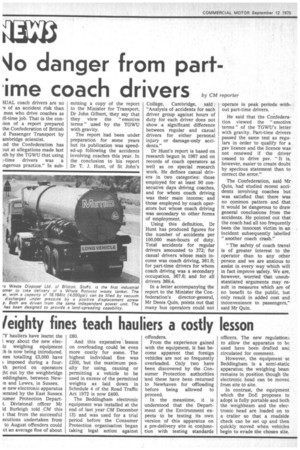/eighty fines teach hauliers a costly lesson
Page 4

If you've noticed an error in this article please click here to report it so we can fix it.
Y hauliers have learnt the 1 way about the new elecic weighing equipment :11 is now being introduced. nes totalling £3,000 have imposed during a fourth period on operators ht out by the weighbridge eddingham, between Newm and Lewes, in Sussex. ie new electronic apparatus nrateci by the East Sussex Rimer Protection Departt. Divisional officer Mr id Burleigh told CM this that from the successful ecutions undertaken from to August offenders could et an average fine of about £60. offenders.
And this expensive lesson on overloading could be even more costly for some. The highest individual fine was £200, but the maximum penalty for using, causing or permitting a vehicle to be used in excess of the permitted weights as laid down in Schedule 4 of the Road Traffic Act 1972 is now £400.
The Beddingham electronic equipment was installed at the end of last year CM December 13) and was used for a trial period before the Consumer Protection organisation began taking legal action against From the experience gained with the equipment, it has become apparent that foreign vehicles are not so frequently overloaded. Only two have been discovered by the Consumer Protection authorities 'and these have been returned to Newhaven for offloading before being allowed to proceed.
In the meantime, it is understood that the Department of the Environment expects to be testing its own version of this apparatus on a pre-delivery site in conjunction with testing standards officers. The new regulatiom to allow the apparatus to be used have been drafted and circulated for comment.
However, the equipment 'at Beddingham is a semi-static apparatus; the weighing beam remains in position though the electronic head can be moved from site to site.
In contrast, the equipment which the DoE proposes to adopt is fully portable and both the weighbeam and the electronic head are loaded on to a trailer so that a roadside check can be set up and then quickly moved when vehicles begin to evade the chosen site.
















































































































